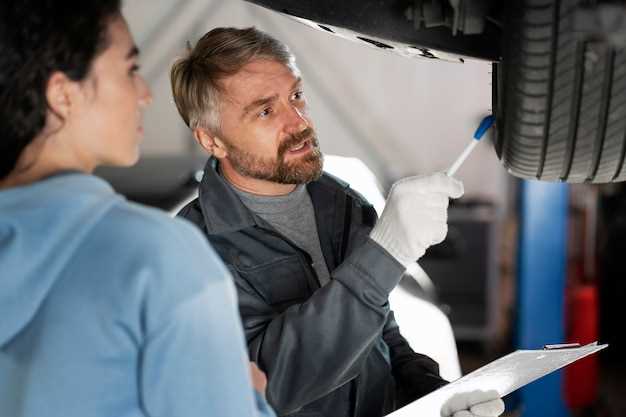
How to check your vehicle’s ball joints
- Dominique Kaye
- 0
- Posted on

Ensuring the proper functioning of your vehicle’s control arms is essential for maintaining safety and performance on the road. Among the key components of the suspension system, ball joints play a critical role in connecting the wheel hub to the control arms. Regular inspection of these joints can help you identify potential issues before they escalate into costly repairs or, more importantly, compromise your safety.
Ball joints serve as pivotal connection points that allow for both vertical and horizontal movement of your vehicle’s suspension. If these joints wear out or become damaged, they can lead to handling problems and uneven tire wear. Therefore, understanding how to effectively inspect your vehicle’s ball joints is crucial for any car owner looking to maintain optimal handling and ride quality.
In this article, we will guide you through the process of inspecting your vehicle’s ball joints, providing step-by-step instructions and highlighting the signs of wear that you should be aware of. By mastering this essential skill, you can ensure that your vehicle remains safe and reliable on all your journeys.
Identifying Signs of Wear and Damage in Ball Joints

Ball joints are crucial components in your vehicle’s suspension system, connecting the control arms to the steering knuckles. Regular inspection is necessary to ensure safety and performance. Here are some signs indicating wear or damage in ball joints:
- Uneven Tire Wear: If you notice uneven patterns on your tires, it may signify that the ball joints are worn and not maintaining proper alignment.
- Steering Issues: Difficulty in steering, such as feeling looseness or play in the steering wheel, can indicate a problem with the ball joints.
- Clunking Noises: Hearing clunking or popping noises when driving over bumps is often a clear sign of deteriorating ball joints.
- Vibration: Excessive vibration in the steering wheel while driving can result from worn ball joints affecting the suspension system.
- Visual Inspection: Look for cracks, rust, or any other visible damage on the ball joint housing. If the boots are torn or leaking grease, replacement may be necessary.
Addressing these signs promptly can prevent further damage and ensure safe vehicle operation. Regular maintenance and inspections can help prolong the life of your vehicle’s suspension system.
Step-by-Step Guide to Physically Inspect Ball Joints and Control Arms

Begin by safely lifting your vehicle using a jack and securing it with jack stands. This will provide access to the suspension components. Ensure the vehicle is on a level surface to prevent any movement during inspection.
Once elevated, visually inspect the control arms for any signs of damage or excessive wear. Look for cracks, bends, or rust that may compromise their integrity. A damaged control arm can affect the performance of the ball joints.
Next, focus on the ball joints. Locate the ball joint housing connected to the control arm and suspension. Check for any visible signs of wear, such as a torn rubber boot or leakage of grease. A damaged boot can lead to contamination and failure of the joint.
To further assess the condition of the ball joints, perform a manual test. Grasp the wheel at the 12 o’clock and 6 o’clock positions and apply pressure while attempting to move the wheel. There should be minimal play. Excessive movement indicates worn ball joints that may require replacement.
Additionally, check the ball joint movement by prying gently on the control arm using a crowbar or similar tool. If the joint moves too freely, it may signal deterioration and should be evaluated for replacement.
Lastly, inspect the mounting points where the ball joints attach to the control arms and suspension. Ensure that the bolts are tight and show no signs of corrosion or damage. Replace any hardware that appears compromised to maintain secure connections.
Tools and Techniques for Accurate Ball Joint Evaluation
To effectively inspect ball joints, it’s essential to use the right tools and techniques. A proper evaluation of these components ensures the safety and performance of your vehicle’s control arms and steering system.
Begin with a jack and jack stands to lift the vehicle safely. Ensure the wheels free from contact with the ground to allow for accurate testing. Once elevated, grasp the wheel at the 12 and 6 o’clock positions and apply pressure. If excessive play is detected, this may indicate a problem with the ball joints.
For a more thorough examination, utilize a ball joint tester. This specialized tool helps assess the integrity of the joints by measuring the amount of movement under load. Follow the manufacturer’s instructions for proper use, ensuring reliable results.
Additionally, inspect the control arms for any signs of wear or damage, as these components directly influence the stability and handling of the vehicle. Check for cracks, rust, or excessive play which may compromise the performance of the ball joints.
Regularly examining the ball joints with these techniques and tools not only prolongs the life of your vehicle but also enhances safety while driving. Make inspections a part of your routine maintenance schedule to ensure all components are in optimal condition.
